The distinction between genuine die doubling and mechanical doubling can be subtle, but they can easily be differentiated with just a loupe and a bit of knowledge.
 One of the more common questions that NGC Customer Service receives is regarding the difference between a doubled die and machine doubling. This distinction is very important, because a doubled die variety may be worth a large premium, while machine doubling is a mere novelty and does not usually add value.
One of the more common questions that NGC Customer Service receives is regarding the difference between a doubled die and machine doubling. This distinction is very important, because a doubled die variety may be worth a large premium, while machine doubling is a mere novelty and does not usually add value.
 A true doubled die is a variety in that it is created during the die making process. As a result, the doubling will appear on every coin struck from that die. In the past, doubled die errors were often much more dramatic due to the process in which dies were created. This method often required multiple impressions from a working hub to impart the detail into a die. If the hub or die shifted at all during this process, the finished die would feature two distinct impressions with separation between them. The design, letters and digits will be doubled.
A true doubled die is a variety in that it is created during the die making process. As a result, the doubling will appear on every coin struck from that die. In the past, doubled die errors were often much more dramatic due to the process in which dies were created. This method often required multiple impressions from a working hub to impart the detail into a die. If the hub or die shifted at all during this process, the finished die would feature two distinct impressions with separation between them. The design, letters and digits will be doubled.
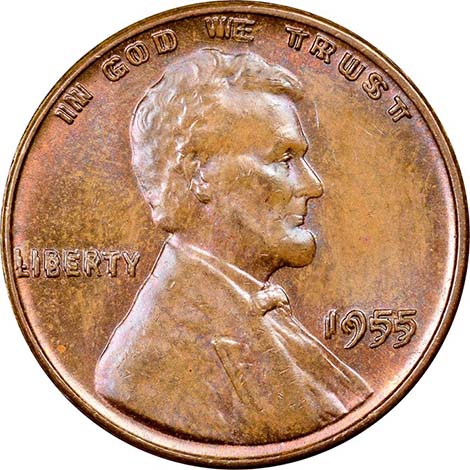
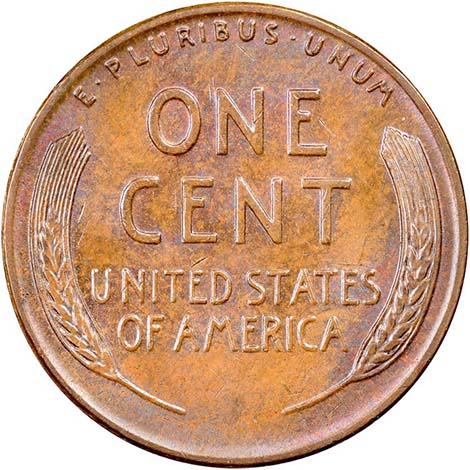
1955 Doubled Die Obverse Lincoln Cent
 One of the most famous doubled die coins is, of course, the 1955 Lincoln Cent with a doubled die obverse. It is extremely rare that such dramatic doubling would slip through unnoticed at the US Mint. At the time, the Philadelphia Mint was running two 12-hour shifts in order to help alleviate a cent shortage. At least seven people were supposed to have inspected the die before it was put into use, but that clearly was not the case here. Instead, the die was placed in service for a midnight to 8:00 am shift. The problem was not discovered until some 20,000-24,000 cents had already been mixed in with the millions of other cents struck that night. The Chief Coiner of the Philadelphia Mint, Sydney C. Engel, decided to let the coins through instead of melting a total of approximately 10 million cents to contain them. Those 1955 Doubled Die Obverse Lincoln cents are now one of the most sought-after varieties in coin collecting.
One of the most famous doubled die coins is, of course, the 1955 Lincoln Cent with a doubled die obverse. It is extremely rare that such dramatic doubling would slip through unnoticed at the US Mint. At the time, the Philadelphia Mint was running two 12-hour shifts in order to help alleviate a cent shortage. At least seven people were supposed to have inspected the die before it was put into use, but that clearly was not the case here. Instead, the die was placed in service for a midnight to 8:00 am shift. The problem was not discovered until some 20,000-24,000 cents had already been mixed in with the millions of other cents struck that night. The Chief Coiner of the Philadelphia Mint, Sydney C. Engel, decided to let the coins through instead of melting a total of approximately 10 million cents to contain them. Those 1955 Doubled Die Obverse Lincoln cents are now one of the most sought-after varieties in coin collecting.
 On the other hand, there is mechanical doubling. This type of doubling, which is also known as strike, ejection, shelf or shift doubling, is not the result of the design on the die being doubled. Rather, this type of doubling occurs when the die strikes a planchet. If the die is not properly seated, it can move slightly or bounce during the moment of striking, creating a flat, shelf-like doubling. This effect will be different on all coins struck, so it is technically not a variety, but rather more of a striking error.
On the other hand, there is mechanical doubling. This type of doubling, which is also known as strike, ejection, shelf or shift doubling, is not the result of the design on the die being doubled. Rather, this type of doubling occurs when the die strikes a planchet. If the die is not properly seated, it can move slightly or bounce during the moment of striking, creating a flat, shelf-like doubling. This effect will be different on all coins struck, so it is technically not a variety, but rather more of a striking error.
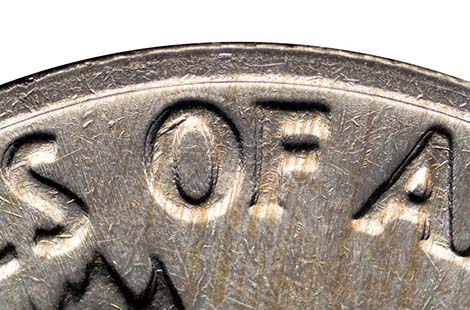
Example of machine or strike doubling
 Above is an example of machine or strike doubling. Notice how the doubling is very flat in appearance and there are serifs in the letters that are not separated.
Above is an example of machine or strike doubling. Notice how the doubling is very flat in appearance and there are serifs in the letters that are not separated.
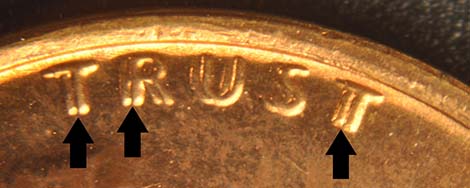
Example of a genuine doubled die coin
 Above is another example of a genuine doubled die coin (the 1972 Doubled Die Obverse Lincoln Cent). Notice how there is a clear separation between the serifs on all the letters. This proves that the doubling was created during the hubbing process rather than during the striking of the actual coin. Sometimes however, both types of doubling can be seen on the same coin, such as on the coin below.
Above is another example of a genuine doubled die coin (the 1972 Doubled Die Obverse Lincoln Cent). Notice how there is a clear separation between the serifs on all the letters. This proves that the doubling was created during the hubbing process rather than during the striking of the actual coin. Sometimes however, both types of doubling can be seen on the same coin, such as on the coin below.
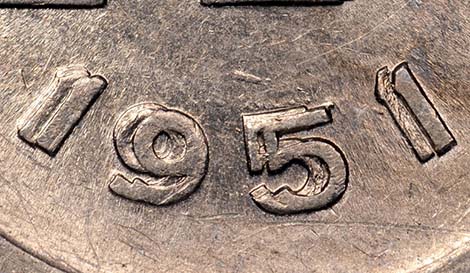
1951 Romania 2 Lei with a doubled die and also mechanical doubling
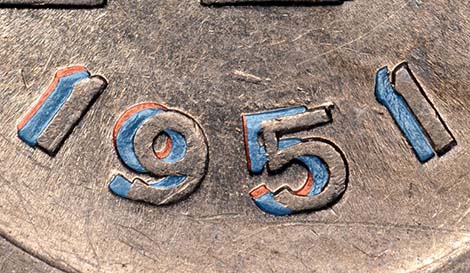
1951 Romania 2 Lei where the doubled die has been shaded blue and the mechanical doubling has been shaded red
 The above coin is a 1951 Romania 2 Lei. There is very pronounced doubling on all the numerals in the date. However, this coin also has mechanical doubling! In the second photo, the doubled die has been shaded blue, whereas the mechanical doubling is red. As you can see, the die doubling looks exactly like the primary numeral only shifted to the west. There is clear separation between the two, including split serifs. On the other hand, the red-shaded strike doubling is much flatter in appearance, and there is no separation between it and the main number.
The above coin is a 1951 Romania 2 Lei. There is very pronounced doubling on all the numerals in the date. However, this coin also has mechanical doubling! In the second photo, the doubled die has been shaded blue, whereas the mechanical doubling is red. As you can see, the die doubling looks exactly like the primary numeral only shifted to the west. There is clear separation between the two, including split serifs. On the other hand, the red-shaded strike doubling is much flatter in appearance, and there is no separation between it and the main number.
 Hunting for varieties can be a very fun and rewarding endeavor, but it is important to know what is truly a variety. Hopefully this article can help you to discern the difference between doubled die coins and coins with mechanical doubling.
Hunting for varieties can be a very fun and rewarding endeavor, but it is important to know what is truly a variety. Hopefully this article can help you to discern the difference between doubled die coins and coins with mechanical doubling.
Sources:
Lange, David W. The Complete Guide to Lincoln Cents. Zyrus Press, 2005.

